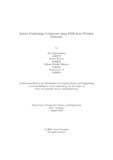| dc.contributor.advisor | Chakrabarty, Amitabha | |
| dc.contributor.author | Sohan, Asif Ahmed | |
| dc.contributor.author | Fairooz, Fabiha | |
| dc.contributor.author | Rahman, Adham Ibrahim | |
| dc.contributor.author | Ali, Mohammad | |
| dc.date.accessioned | 2021-11-21T04:51:31Z | |
| dc.date.available | 2021-11-21T04:51:31Z | |
| dc.date.copyright | 2019 | |
| dc.date.issued | 2019-08 | |
| dc.identifier.other | ID 15301072 | |
| dc.identifier.other | ID 15301061 | |
| dc.identifier.other | ID 15301091 | |
| dc.identifier.other | ID 15301054 | |
| dc.identifier.uri | http://hdl.handle.net/10361/15628 | |
| dc.description | This thesis is submitted in partial fulfillment of the requirements for the degree of Bachelor of Science in Computer Science and Engineering, 2019. | en_US |
| dc.description | Cataloged from PDF version of thesis. | |
| dc.description | Includes bibliographical references (pages 25-26). | |
| dc.description.abstract | The whole world is familiar with the Global Positioning System or GPS which can
identify the exact position of any object with the help of satellites. Yet GPS signals
are not available indoors. To overcome this, Indoor Positioning System(IPS) is
used which enables us to locate objects inside an indoor environment. Our goal is
to build an Indoor Positioning System by estimating the location using Received
Signal Strength Indication (RSSI) through wireless networks. The proposed model
will determine the position of wireless devices in a room. We took the RSSI values as
coordinates and speci c reference points at every two meters making the room into
a grid. The RSSI values on the reference point are measured. The position of the
wireless devices will be estimated from the reference points using the trilateration
method and the ITU indoor path loss model.
With the aforementioned process, we calculated the position using the ITU indoor
path loss model and trilateration. Using the ITU indoor path loss model our mean
error was 1.01166m and while using trilateration it was 1.22m. | en_US |
| dc.description.statementofresponsibility | Asif Ahmed Sohan | |
| dc.description.statementofresponsibility | Fabiha Fairooz | |
| dc.description.statementofresponsibility | Adham Ibrahim Rahman | |
| dc.description.statementofresponsibility | Mohammad Ali | |
| dc.format.extent | 26 pages | |
| dc.language.iso | en | en_US |
| dc.publisher | Brac University | en_US |
| dc.rights | Brac University theses are protected by copyright. They may be viewed from this source for any purpose, but reproduction or distribution in any format is prohibited without written permission. | |
| dc.subject | Indoor positioning | en_US |
| dc.subject | WiFi | en_US |
| dc.subject | RSSI | en_US |
| dc.subject | Trilateration | en_US |
| dc.subject | ITU | en_US |
| dc.subject.lcsh | Wireless sensor networks. | |
| dc.subject.lcsh | Indoor positioning systems (Wireless localization) | |
| dc.title | Indoor positioning techniques using RSSI from wireless networks | en_US |
| dc.type | Thesis | en_US |
| dc.contributor.department | Department of Computer Science and Engineering, Brac University | |
| dc.description.degree | B. Computer Science | |

